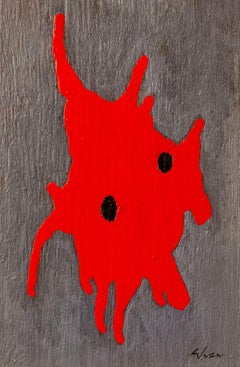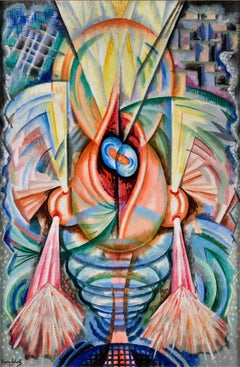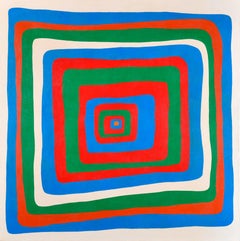About Lincoln Glenn
Lincoln Glenn, LLC was founded in 2021, with a mission to present American art from the 19th century to the contemporary period. The gallery exhibits works from artists of the Hudson River School, American Impressionism, Ashcan School, and American Modernism, with a particular focus on Abstract Expressionism and Color Field painting. Lincoln Glenn wishes to revive the legacies and explore the careers of artists working between the 1950s and 1970s who made significant contributions to art history, but whose names may have been forgotten by time. Lincoln Glenn is proud t...Read More
Featured Pieces
"Green" Op Art Abstract Blue And Green Geometric Composition
By Sewell Sillman
Located in New York, NY
Sewell Sillman
Green, circa 1958
Acrylic on masonite
21.5 x 28 inches
Upon attending Black Mountain College in Asheville, North Carolina, Sewell Sillman’s life was arguably altered...
Category
1950s Abstract Abstract Paintings
Materials
Masonite, Acrylic
"Happening" Abstract, Vibrant Red Composition, Mid Century Abstraction
By Charles Green Shaw
Located in New York, NY
Charles Green Shaw
Happening, 1964
Signed and dated on verso
Oil on board
8.75 x 6 inches
Charles Green Shaw, born into a wealthy New York family, began painting when he was in his...
Category
1960s Abstract Abstract Paintings
Materials
Oil, Board
"Untitled" Dynamic Fractured Perspectives Abstract Composition, Oil on canvas
Located in New York, NY
Frederick Buchholz
Untitled, circa 1927
Signed lower left
Oil on canvas
30 x 20 inches
Frederick Buchholz, born 1901 in Springfield, Massachusetts, was an industrial-era modernist ...
Category
1920s Abstract Abstract Paintings
Materials
Canvas, Oil
"The Eyes Have It" Colorist Abstract Acrylic Work, Washington Color School
Located in New York, NY
Ralph de Burgos
The Eyes Have It, 1972
Signed and titled on verso
Acrylic painting on canvas
36 x 36 inches
Ralph de Burgos was a well known Washington D.C artist who served as Pre...
Category
1970s Abstract Abstract Paintings
Materials
Canvas, Acrylic
"Red" Geometric Abstraction, Op Art, Red Colorist Composition Acrylic Painting
By Sewell Sillman
Located in New York, NY
Sewell Sillman
Red, circa 1958
Acrylic on masonite
18 x 36 inches
Upon attending Black Mountain College in Asheville, North Carolina, Sewell Sillman’s life was arguably altered for...
Category
1950s Abstract Abstract Paintings
Materials
Masonite, Acrylic
"Untitled" Ultra Marine Blue and Steel Architectural Sculpture by Female Artist
By Beverly Pepper
Located in New York, NY
Beverly Pepper
Untitled, circa 1965-1970
Stamped: BP
Steel and Enamel paint
11.75 x 8 x 3.75 inches
A formidable opponent of the status quo, Beverly Pepper took on industrial sculpture at a time when many women were unfamiliar with how to operate power tools. Born in Brooklyn in 1922 to the children of Jewish immigrants, Pepper was never told that there would be roadblocks in her future simply because of her gender. Her mother never imposed the idea of necessary femininity on her daughter, so it likely came as a shock to the young artist when she was removed from an industrial design course during her first year at Pratt University at 16 years old because the school decided that she was not capable of operating machinery as a woman. Despite this hiccup, the exposure to the course while she was enrolled sparked a lifelong interest in the industrial arts that would resurface later in life. From there, Pepper turned to painting and went on to study at L’Académie de la Grande Chaumière in Paris, where artists like Giacometti, Modigliani, and others had studied. During this time, Pepper met and married her husband Curtis Bill Pepper, moving to Italy for his work in the 1950’s. She settled with her family in the country, where she maintained a studio in Umbria until her death.
It was not until 1960 that Pepper shifted her focus to sculpture after a visit to Angkor Wat in Cambodia, forever moved by the relationship between temple ruins and the accompanying overgrowth from the surrounding jungle. She debuted her sculpture with an exhibition of carved tree trunks in Rome two years later, and soon after was invited to participate in a festival in Spoleto – the only catch being that she was asked to provide works on metal, and she did not know how to weld. Convincing a local ironmaker to teach her how to weld, she produced works for the Spoleto show and was one of only three women that were exhibited alongside great sculptors like Alexander Calder and Henry Moore. After that show, she was invited to work in a factory in Northern Italy and never looked back, finding the factory an ideal place to create the large scale sculptures she is so well known for today. This venue of choice, the factory, was quite a boys club – Pepper was the only female in the building much of the time, and frequently had to use the men’s restroom as there were none designated for women. While working at a US Steel factory in Pennsylvania, the company suggested she try out their new material: Cor-Ten steel. Pepper asserts that she was likely the first artist to work with the material, one that became a favorite in her own sculptures. Her studio in Italy was a converted aircraft hangar...
Category
1960s Modern Abstract Sculptures
Materials
Enamel, Steel
"Untitled (New England Landscape)" Modernist New England Landscape
By Kyohei Inukai
Located in New York, NY
Kyōhei Inukai
Untitled (New England Landscape), circa 1930
Signed Lower Right: Inukai
Oil on canvas
32 x 40.5 inches
Kyōhei Inukai (Earle Goodenow) lived in New York in the 1930s a...
Category
1930s Modern Abstract Paintings
Materials
Canvas, Oil
"Reclining Woman" Bronze Portrait, Reclining Woman with Reddish Patina
Located in New York, NY
Karl Bitter
Reclining Woman, 1897
Signed: Bitter 97
Stamped: GORHAM M F G CO.
Bronze
10.25 x 10.25 x 4 inches
Initially from Vienna, Karl Bitter first studied art at the city’s Kun...
Category
1890s Realist Figurative Sculptures
Materials
Bronze
"Ann Arbor" Iron Sculpture, Mechanical and Technological Abstract Forms
By Julius Schmidt
Located in New York, NY
Julius Schmidt
Ann Arbor, 1960
Signed and dated interior: 1960 Schmidt 6
Cast iron
30 x 9.5 x 7.75 inches
Julius Schmidt, Professor Emeritus of Sculpture at the University of Iowa...
Category
1960s Abstract Abstract Sculptures
Materials
Iron
Matrona
By Suzan Frecon
Located in New York, NY
Suzan Frecon
Matrona
Watercolor on Indian paper
14 x 18 inches
Suzan Frecon is a painter known for her large scale abstract works. She describes her artistic practice as a quest, sa...
Category
20th Century Abstract Paintings
Materials
Paper, Watercolor
"Cronus Asleep in the Cave" Large Acrylic Abstract Composition by David Hare
By David Hare
Located in New York, NY
David Hare
Cronus Asleep in the Cave, 1971
Acrylic on linen
55 x 67 inches
“Freedom is what we want,” David Hare boldly stated in 1965, but then he added the caveat, “and what we are most afraid of.” No one could accuse David Hare of possessing such fear. Blithely unconcerned with the critics’ judgments, Hare flitted through most of the major art developments of the mid-twentieth century in the United States. He changed mediums several times; just when his fame as a sculptor had reached its apogee about 1960, he switched over to painting. Yet he remained attached to surrealism long after it had fallen out of official favor. “I can’t change what I do in order to fit what would make me popular,” he said. “Not because of moral reasons, but just because I can’t do it; I’m not interested in it.”
Hare was born in New York City in 1917; his family was both wealthy and familiar with the world of modern art. Meredith (1870-1932), his father, was a prominent corporate attorney. His mother, Elizabeth Sage Goodwin (1878-1948) was an art collector, a financial backer of the 1913 Armory Show, and a friend of artists such as Constantin Brancusi, Walt Kuhn, and Marcel Duchamp.
In the 1920s, the entire family moved to Santa Fe, New Mexico and later to Colorado Springs, in the hope that the change in altitude and climate would help to heal Meredith’s tuberculosis. In Colorado Springs, Elizabeth founded the Fountain Valley School where David attended high school after his father died in 1932. In the western United States, Hare developed a fascination for kachina dolls and other aspects of Native American culture that would become a recurring source of inspiration in his career.
After high school, Hare briefly attended Bard College (1936-37) in Annandale-on-Hudson. At a loss as to what to do next, he parlayed his mother’s contacts into opening a commercial photography studio and began dabbling in color photography, still a rarity at the time [Kodachrome was introduced in 1935]. At age 22, Hare had his first solo exhibition at Walker Gallery in New York City; his 30 color photographs included one of President Franklin Roosevelt.
As a photographer, Hare experimented with an automatist technique called “heatage” (or “melted negatives”) in which he heated the negative in order to distort the image. Hare described them as “antagonisms of matter.” The final products were usually abstractions tending towards surrealism and similar to processes used by Man Ray, Raoul Ubac, and Wolfgang Paalen.
In 1940, Hare moved to Roxbury, CT, where he fraternized with neighboring artists such as Alexander Calder and Arshile Gorky, as well as Yves Tanguy who was married to Hare’s cousin Kay Sage, and the art dealer Julian Levy. The same year, Hare received a commission from the American Museum of Natural History to document the Pueblo Indians. He traveled to Santa Fe and, for several months, he took portrait photographs of members of the Hopi, Navajo, and Zuni tribes that were published in book form in 1941.
World War II turned Hare’s life upside down. He became a conduit in the exchange of artistic and intellectual ideas between U.S. artists and the surrealist émigrés fleeing Europe. In 1942, Hare befriended Andre Breton, the principal theorist of surrealism. When Breton wanted to publish a magazine to promote the movement in the United States, he could not serve as an editor because he was a foreign national. Instead, Breton selected Hare to edit the journal, entitled VVV [shorth for “Victory, Victory, Victory”], which ran for four issues (the second and third issues were printed as a single volume) from June 1942 to February 1944. Each edition of VVV focused on “poetry, plastic arts, anthropology, sociology, (and) psychology,” and was extensively illustrated by surrealist artists including Giorgio de Chirico, Roberto Matta, and Yves Tanguy; Max Ernst and Marcel Duchamp served as editorial advisors.
At the suggestion of Jacqueline Lamba...
Category
1970s Abstract Paintings
Materials
Linen, Acrylic
"Cronus Waiting" Acrylic on Linen Abstract Surrealist Scene by David Hare
By David Hare
Located in New York, NY
David Hare
Cronus Waiting, 1990
Acrylic on linen
72 x 42 inches
“Freedom is what we want,” David Hare boldly stated in 1965, but then he added the caveat, “and what we are most afraid of.” No one could accuse David Hare of possessing such fear. Blithely unconcerned with the critics’ judgments, Hare flitted through most of the major art developments of the mid-twentieth century in the United States. He changed mediums several times; just when his fame as a sculptor had reached its apogee about 1960, he switched over to painting. Yet he remained attached to surrealism long after it had fallen out of official favor. “I can’t change what I do in order to fit what would make me popular,” he said. “Not because of moral reasons, but just because I can’t do it; I’m not interested in it.”
Hare was born in New York City in 1917; his family was both wealthy and familiar with the world of modern art. Meredith (1870-1932), his father, was a prominent corporate attorney. His mother, Elizabeth Sage Goodwin (1878-1948) was an art collector, a financial backer of the 1913 Armory Show, and a friend of artists such as Constantin Brancusi, Walt Kuhn, and Marcel Duchamp.
In the 1920s, the entire family moved to Santa Fe, New Mexico and later to Colorado Springs, in the hope that the change in altitude and climate would help to heal Meredith’s tuberculosis. In Colorado Springs, Elizabeth founded the Fountain Valley School where David attended high school after his father died in 1932. In the western United States, Hare developed a fascination for kachina dolls and other aspects of Native American culture that would become a recurring source of inspiration in his career.
After high school, Hare briefly attended Bard College (1936-37) in Annandale-on-Hudson. At a loss as to what to do next, he parlayed his mother’s contacts into opening a commercial photography studio and began dabbling in color photography, still a rarity at the time [Kodachrome was introduced in 1935]. At age 22, Hare had his first solo exhibition at Walker Gallery in New York City; his 30 color photographs included one of President Franklin Roosevelt.
As a photographer, Hare experimented with an automatist technique called “heatage” (or “melted negatives”) in which he heated the negative in order to distort the image. Hare described them as “antagonisms of matter.” The final products were usually abstractions tending towards surrealism and similar to processes used by Man Ray, Raoul Ubac, and Wolfgang Paalen.
In 1940, Hare moved to Roxbury, CT, where he fraternized with neighboring artists such as Alexander Calder and Arshile Gorky, as well as Yves Tanguy who was married to Hare’s cousin Kay Sage, and the art dealer Julian Levy. The same year, Hare received a commission from the American Museum of Natural History to document the Pueblo Indians. He traveled to Santa Fe and, for several months, he took portrait photographs of members of the Hopi, Navajo, and Zuni tribes that were published in book form in 1941.
World War II turned Hare’s life upside down. He became a conduit in the exchange of artistic and intellectual ideas between U.S. artists and the surrealist émigrés fleeing Europe. In 1942, Hare befriended Andre Breton, the principal theorist of surrealism. When Breton wanted to publish a magazine to promote the movement in the United States, he could not serve as an editor because he was a foreign national. Instead, Breton selected Hare to edit the journal, entitled VVV [shorth for “Victory, Victory, Victory”], which ran for four issues (the second and third issues were printed as a single volume) from June 1942 to February 1944. Each edition of VVV focused on “poetry, plastic arts, anthropology, sociology, (and) psychology,” and was extensively illustrated by surrealist artists including Giorgio de Chirico, Roberto Matta, and Yves Tanguy; Max Ernst and Marcel Duchamp served as editorial advisors.
At the suggestion of Jacqueline Lamba...
Category
1990s Abstract Figurative Paintings
Materials
Linen, Acrylic
Featured Creators




